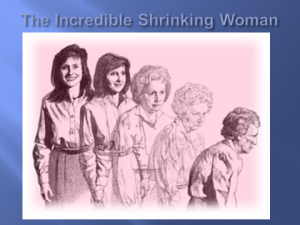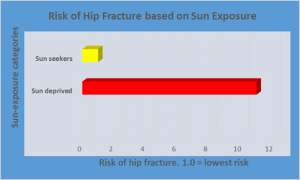Sun exposure and health… by Dr. Marc Sorenson, Sunlight Institute…
Lack of vitamin D, which is produced by sun exposure, leads to rickets, osteoporosis, osteomalacia and other bone diseases. In addition, research well after the first discovery of vitamin D has shown that vitamin D deficiency and sunlight deprivation also lead to many cancers, heart disease and multiple additional maladies. Now, as the world has modernized, the population is moving indoors, and even in the areas that are sunny throughout the year, sunlight exposure and vitamin D deficiency is increasing, both in rural and urban populations. The bones become so weakened without regular sun exposure, that the slightest movement may cause a fracture. As an example, the mother of an acquaintance of mine—a woman who avoided the sun—turned over in bed one night and broke her hip. Osteoporosis often destroys all quality or life for those who suffer it.
The importance of the sun in maintaining and producing strong bones has been known since antiquity. Dr. Richard Hobday, author of The Healing Sun, writes the following comments along with a history in an online article.[1] “Traditionally, sunlight deprivation has been linked with weak or brittle bones. One of the earliest references to this was made more than two thousand years ago by the Greek historian Herodotus (480-425 BC), who noted a marked difference between the remains of the Egyptian and Persian casualties at the site of battle of Pelusium which took place in 525 BC:
‘At the place where this battle was fought I saw a very odd thing, which the natives had told me about. The bones still lay there, those of the Persian dead separate from those of the Egyptian, just as they were originally divided, and I noticed that the skulls of the Persians were so thin that the merest touch with a pebble will pierce them, but those of the Egyptians, on the other hand, are so tough that it is hardly possible to break them with a blow from a stone. I was told, very credibly, that the reason was that the Egyptians shave their heads from childhood, so that the bone of the skull is indurated by the action of the sun — this is why they hardly ever go bald, baldness being rarer in Egypt than anywhere else. This, then, explains the thickness of their skulls; and the thinness of the Persian’s skulls rests upon a similar principle: namely that they have always worn felt skull -caps, to guard their heads from the sun.’
Herodotus, ‘The Histories’”
And here is a perhaps the transcendent study on hip fracture and sun exposure: research in Spain showed that women who were sun seekers had only about one-eleventh the risk of hip fracture as those who stayed indoors[2] (See the chart below).
That is very powerful evidence of the efficacy of sun in preventing weak bones. In stark contrast to this research are studies done on women who completely avoid the sun and suffer from osteomalacia. Osteomalacia is a soft-bone disease known as adult rickets, resulting from severe vitamin D deficiency, which deficiency prevents bone from properly mineralizing. Women who seldom go outdoors, or who are nearly always fully covered with clothing, have an extremely high incidence of osteomalacia at a very young age, even if they live in geographical areas with abundant sunlight.[3] [4] If one is never exposed to the available sun, the sun will not be able to produce its beneficial effects on the body, so one may as well live at the North Pole.
Sunbed use also is associated with stronger bones and higher vitamin D levels. An excellent study compared 50 people who used sunbeds regularly with 106 who did not.[5] The sunbed group had 90% higher vitamin D, significantly higher bone density and lower PTH levels (high PTH levels are associated with lower bone mass). The users had healthful vitamin D levels of 46 ng/ml [115 nmol/L] compared to only 24 ng/ml [60 nmol/L] for those who did not regularly use sunbeds.
Scientists at one time believed that sunlight and vitamin D were good only for preventing rickets, osteoporosis and other bone weaknesses. That belief has been supplanted by myriad research studies that show the efficacy of both sun exposure and vitamin D repletion on protection against numerous additional diseases. Nevertheless, we should never forget the extraordinary, never-changing value of sun exposure to maintaining a strong skeleton well into old age.
[1]Richard Hobday. The Healing sun: Sunlight, Brittle Bones, and Osteoporosis. http://sunlightenment.com/the-healing-sun-sunlight-brittle-bones-and-osteoporosis/. (accessed February 5, 2016)
[2] Larrosa M, Casado E, Gómez A, Moreno M, Berlanga E, Ramón J, Gratacós J. Vitamin D deficiency and related factors in patients with osteoporotic hip fracture. Med Clin (BARC) 2008;130:6-9.
[3] Sahibzada AS, Khan MS, Javed M. Presentation of osteomalacia in Kohistani women. J Ayub Med Coll Abbottabad 2004;16:63-5
[4] Al-Jurayyan NA, El-Desouki ME, Al-Herbish AS, Al-Mazyad AS, Al-Qhtani MM. Nutritional rickets and osteomalacia in school children and adolescents. Saudi Med J 2002;23:182-85.
[5] Tangpricha V, Turner A, Spina C, Decastro S, Chen TC, Holick MF. Tanning is associated with optimal vitamin D status (serum 25-hydroxyvitamin D concentration) and higher bone mineral density. Am J Clin Nutr. 2004 Dec;80(6):1645-9.
By Marc Sorenson, EdD Sunlight Institute…
Research from Singapore, a very sunny country, demonstrated that 57% of older adults with hip fractures were vitamin D deficient.[1] The researchers note that in Western countries with seasonal winters, D deficiency is common due to the reduction in sunlight. But on measuring serum vitamin D in fracture patients in sunny Singapore, they found that 57.5% were suffering deficiency and 34.5% were suffering insufficiency. Only 8% of the patients had normal vitamin D levels.
One might ask why people residing in a sunny, predominantly tropical climate would have such a high degree of vitamin D deficiency and consequently high fracture risk. Further study found the answer: Most of the people who suffered fractures had been housebound and had little sun exposure. The authors of the paper made the following statement: “Another factor was Malay ethnicity (dark skin, which inhibits vitamin D production), and clothing habits that prevented sun exposure.”
The authors of the paper concluded with this statement: “Vitamin D deficiency and insufficiency are common in patients with hip fracture in Singapore. Vitamin D deficiency was associated with being housebound and those of Malay ethnicity. Clothing habits resulting in reduced sunlight exposure may increase the risk of vitamin D deficiency.”
The same pattern of high D deficiency also exists among youth in some sunny countries; in Qatar deficiency is common. [2] Sixty-eight percent of the children there are deficient and the girls are especially likely to be deficient. Low duration of time spent outdoors is a major predictor of deficiency, and the children who are deficient suffer a greater incidence of rickets, fractures, and gastroenteritis.
And finally, I would like to remind the readers of research from Spain that I have cited on various occasions. Women who spend their time indoors are about 11 times more likely to have a fracture as those who regularly seek the sun.[3]
A major message is this: If the sunlight is all around you and you don’t expose yourself to it, it will do you no good. You may a well live in the Arctic Circle.
Carefully embrace the sun and save your bones.
[1] Ramason R, Selvaganapathi N, Ismail NH, Wong WC, Rajamoney GN, Chong MS. Prevalence of vitamin D deficiency in patients with hip fracture seen in an orthogeriatric service in sunny Singapore. Geriatr Orthop Surg Rehabil. 2014 Jun;5(2):82-6
[2] Bener A, Al-Ali M, Hoffmann GF. High prevalence of vitamin D deficiency in young children in a highly sunny humid country: a global health problem. Minerva Pediatr. 2009 Feb;61(1):15-22.
[3] Larrosa M, Casado E, Gómez A, Moreno M, Berlanga E, Ramón J, Gratacós J. Vitamin D deficiency and related factors in patients with osteoporotic hip fracture. Med Clin (BARC) 2008;130:6-9.
By Marc Sorenson, EdD, Sunlight Institute
Nearly all research shows a positive association between sunlight and bone strength. One of the most interesting of these studies measured heel-bone stiffness (a measurement of bone strength) and various lifestyle factors among Okinawan men with and without type-two diabetes.[i]
The research demonstrated that among the group with type-two diabetes, there were a significant negative correlation between cigarette smoking heel bone stiffness. That negative correlation also was evident with age. Other factors did not produce a significant correlation in the diabetic group; however, in the non-diabetic (control) group, a significant positive correlation was shown between heel-bone stiffness and two other factors: (1) sunlight exposure and (2) consumption of small fish. Of the two, sunlight exposure predicted greater bone strength.
It is probable that the vitamin D produced by sunlight exposure led to increased heel bone strength in the control group. It is also possible that lack of sunlight in the diabetic group may have been one of the predisposing factors that initially led to diabetes in the diabetic group, as it has been shown that vitamin D supplementation in pre-diabetic subjects predict a dramatically reduced risk of developing the full-blown disease.[ii] Sunlight exposure, of course, is the most natural way to produce vitamin D.
Keep your heels—and the rest or your bones—strong by obtaining plenty of non-burning sunlight!
[i] Michiko Gushiken, Ichiro Komiya, Shinichiro Ueda, Jun Kobayashi. Heel bone strength is related to lifestyle factors in Okinawan men with type 2 diabetes mellitus. J Diabetes Invest 2015; 6: 150–157
[ii] Pittas, A. et al. The effects of calcium and vitamin D supplementation on blood glucose and markers of inflammation in nondiabetic adults. Diabetes Care 2007;30:980-86.


